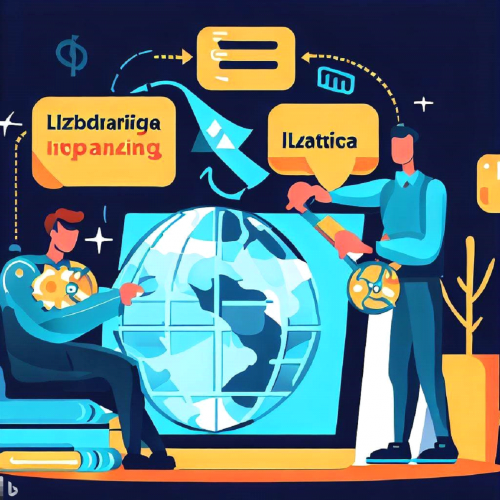Table of contents
- Introduction to Software Localization Services
- Understanding the Process of Software Localization Services
- Choosing the Right Software Localization Services Provider
- Preparing Your Software for Localization
- The Role of Translation in Software Localization
- Cultural Adaptation in Software Localization
- User Interface and User Experience (UI/UX) in Software Localization
- Testing and Quality Assurance in Software Localization
- Post-Localization Maintenance and Updates
- Common Challenges in Software Localization
- Conclusion: Embracing Software Localization for Global Success
Software Localization Services: Skyrocket Your Growth in Global Markets

Introduction
In today’s interconnected world, the software industry is experiencing unparalleled growth and global expansion. As businesses strive to tap into international markets, the need for software localization services has become increasingly evident. Software localization is not just about translating the text into different languages; it encompasses adapting the entire user experience to cater to diverse cultural preferences and linguistic nuances. In this blog, we will take a deep dive into the world of software localization services and explore its significance, benefits, challenges, and best practices that will help you successfully navigate the global landscape.

What are Software Localization Services?
Software localization services undertake the responsibility of adapting a software product to suit the language, culture, and target market of specific regions or countries. It goes beyond mere translation, involving the customization of various elements, such as text, graphics, icons, date formats, and more. This comprehensive approach ensures that the software resonates with users from different linguistic and cultural backgrounds, providing them with a seamless and personalized experience. In addition to linguistic adaptation, software localization services also consider cultural nuances and user preferences. This involves tailoring the user interface and user experience (UI/UX) to align with the cultural norms and sensitivities of the target audience. This may include modifying colors, symbols, icons, and even layout designs to ensure that the software feels native and familiar to users in each specific market. By investing in software localization services, businesses can establish a deeper connection with their global users, enhance user satisfaction, and gain a competitive edge in the international market.
1.1 Why are Software Localization Services Important?
a) Expanded Market Reach:
In today’s globalized economy, businesses can no longer afford to limit themselves to local markets. Software localization services enable companies to break through language barriers and connect with users from different countries and regions. By offering their product in multiple languages, businesses can tap into new markets, reaching a diverse audience that may have otherwise remained untapped. This expanded market reach presents significant growth opportunities and can lead to increased customer acquisition and retention.
b) Improved User Experience:
User experience is a critical factor in the success of any software product. When users encounter software that is available in their native language, with culturally relevant content and intuitive interfaces, they are more likely to feel comfortable and confident using it. This positive user experience fosters higher user satisfaction and engagement, reducing the likelihood of churn. Localized software shows that a company cares about its users’ needs, increasing brand loyalty and positive word-of-mouth recommendations.
c) Enhanced Brand Reputation:
Brand reputation is built on trust, credibility, and a strong connection with customers. Software localization services demonstrate a commitment to understanding and respecting different cultures, which can significantly impact a brand’s perception. When users see a software product that speaks their language and addresses their cultural norms, they are more likely to view the brand as authentic and inclusive. Positive brand perception can lead to a competitive advantage, as users tend to choose companies they trust and relate to on a personal level.
d) Increased Revenue Opportunities:
Software localization services can open doors to new revenue streams by allowing businesses to enter previously untapped markets. As the software gains popularity in different regions, it attracts a larger customer base and increases the potential for recurring revenue through subscriptions, purchases, or licensing agreements. Moreover, localization can lead to partnerships with local distributors or resellers, further expanding the software’s market presence and revenue potential.
Understanding the Software Localization Process:
To achieve successful software localization, businesses need to follow a well-structured process that encompasses various stages:
Source Code Analysis:
The process begins with a thorough analysis of the software’s source code to identify all text elements that require translation or adaptation. This analysis lays the groundwork for a seamless localization process.
String Extraction:
Once the source code analysis is complete, the relevant text strings are extracted from the software. These strings are then prepared for translation, making the localization process more efficient and accurate.
Text Translation:
Professional translators, well-versed in the target languages and subject matter, carry out the translation of the extracted text. The translation process ensures linguistic accuracy and context-specific adaptations.
Linguistic and Cultural Adaptation:
Localization goes beyond word-for-word translation. It involves linguistic and cultural adaptation to ensure that the content resonates with the target audience. This includes adjusting humour, idioms, symbols, and other elements to fit the cultural context.

UI/UX Adaptation:
The User Interface and User Experience are critical components of software localization. Adapting the design, layout, and navigation to suit the preferences of different cultures enhances usability and overall user satisfaction.
Testing and Quality Assurance:
Comprehensive localization testing is essential to identify and resolve any issues related to translated content, layout, functionality, and overall user experience. Rigorous quality assurance ensures that the localized software meets the highest standards.
Deployment and Maintenance:
Once the localization process is complete, the localized software is ready for deployment in the target markets. Ongoing maintenance ensures that the software remains relevant, up-to-date, and aligned with evolving user needs.
2.1 Source Code Analysis:
The localization process begins with a thorough analysis of the software’s source code. This step identifies all the text elements that require translation or adaptation.
2.2 String Extraction:
Once the source code analysis is complete, the next step is to extract the strings that need translation, making them accessible for localization.
2.3 Text Translation:
The heart of software localization lies in accurate and contextually appropriate translation. Professional translators who are experts in the target languages carry out this task.
2.4 Linguistic and Cultural Adaptation:
In addition to translation, cultural adaptation involves modifying content to suit local preferences, such as humour, idiomatic expressions, and etiquette.
2.5 UI/UX Adaptation:
The User Interface and User Experience (UI/UX) play a pivotal role in software localization. Adapting the design, layout, and navigation ensures a seamless user experience across languages.
2.6 Testing and Quality Assurance:
Localization testing is vital to identify and resolve any issues related to translated content, layout, or functionality before releasing the software to the target markets.
2.7 Deployment and Maintenance:
After successful testing, the localized software is ready for deployment in the target regions. Ongoing maintenance and updates ensure that the software remains relevant and up-to-date.
Choosing the Right Software Localization Services Provider:
Selecting the right localization services provider is crucial for the success of your software in the global market. Consider the following factors when making your decision:
3.1 Evaluating Localization Expertise:
Look for a provider with extensive experience in software localization services, as this expertise will significantly impact the quality of the final product.
3.2 Language and Regional Support:
Ensure that the provider offers software localization services in the languages and regions where you plan to expand.
3.3 Industry-Specific Experience:
Choose a provider familiar with your industry, as this knowledge will enable them to handle industry-specific terminology and nuances effectively.
3.4 Tools and Technology:
A provider that utilizes the latest localization tools and technology can streamline the process and improve efficiency.
3.5 Reputation and Customer Reviews:
Check the provider’s reputation and read customer reviews to gauge their reliability and quality of service.
3.6 Cost Considerations:
While cost is a crucial factor, it is essential to strike a balance between affordability and the level of service provided.
Preparing Your Software for Localization:
To facilitate a smooth localization process, it is essential to prepare your software for internationalization:
4.1 Internationalization vs. Localization:
Internationalization involves designing the software in a way that allows easy adaptation to various languages and regions. It is a prerequisite for successful localization.
4.2 Best Practices for Internationalization:
Follow established internationalization best practices, such as separating code from content and avoiding hard-coded text.
4.3 Identifying Localizable Content:
Identify all content elements, including text, images, icons, dates, and formats, that will require localization.

4.4 Externalizing Strings and Resources:
Externalize all text strings and resources to make them accessible for translation and localization.
4.5 Handling Variables and Dynamic Content:
Take into account variables and dynamic content that may affect the length and context of the translated text.
4.6 Graphics and UI Elements:
Consider cultural differences when using graphics and UI elements to avoid misinterpretation or offense.
The Role of Translation in Software Localization Services:
The translation is at the core of software localization services. To ensure high-quality translations, consider the following:
5.1 Translation Challenges and Considerations:
Address common challenges in translation, such as ambiguous source text, colloquial expressions, and linguistic variations.
5.2 Working with Professional Translators:
Collaborate with experienced and qualified translators who specialize in the software localization services industry and target languages.
5.3 CAT (Computer-Aided Translation) Tools:
CAT tools can improve translation consistency, efficiency, and cost-effectiveness.
5.4 Maintaining Consistency Across Languages:
Maintaining consistency in terminology and style across languages enhances the user experience.
5.5 Handling Non-Textual Content (Images, Icons, etc.):
Ensure that non-textual content aligns with the cultural norms and sensitivities of the target audience.
5.6 Legal and Cultural Aspects of Translation:
Be aware of legal considerations and cultural sensitivities that may affect certain translated content.
Conclusion: Embracing Software Localization Services for Global Success
Software localization services provide an indispensable strategy for businesses seeking global success. By adapting your software to cater to diverse cultures and languages, you can connect with users on a more personal level, gaining their trust and loyalty. Remember, successful localization requires a well-planned and expertly executed process, which starts with selecting the right software localization services provider and preparing your software for internationalization. Embrace the power of software localization services to unlock new market opportunities, elevate your brand, and create meaningful user experiences across the globe. The journey may be challenging, but the rewards are well worth it, leading your software to reach new heights of global success. Furthermore, software localization services not only open doors to new markets but also allows businesses to gain valuable insights into the preferences and behaviour of users from different regions. By localizing software, companies can analyse user feedback, reviews, and usage patterns, enabling them to make data-driven decisions for future updates and improvements. This iterative approach to software development fosters a sense of continuous improvement and responsiveness to the evolving needs of diverse global audiences. As the world becomes increasingly interconnected, software localization services are no longer just a choice but a necessity for businesses looking to thrive in the global arena. Ignoring the importance of localization may lead to missed opportunities, potential misunderstandings, and even damage to a brand’s reputation due to cultural insensitivity. In contrast, companies that invest in software localization position themselves as global players, capable of delivering exceptional user experiences tailored to each market’s unique preferences.

In conclusion, software localization services act as a powerful tool that empowers businesses to transcend linguistic and cultural barriers, creating a truly inclusive and engaging user experience for their diverse global audience. By partnering with experienced localization services providers, meticulously preparing the software for internationalization, and being receptive to user feedback, companies can pave the way for unparalleled success in the global market. Embrace software localization services as a strategic imperative, and watch your software product flourish on the international stage, establishing a strong presence and winning the hearts of users worldwide.

Made up your mind yet?
Empower your globalization goals today!




